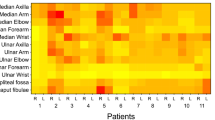Abstract
Objectives
Our aim was to evaluate the ability of magnetic resonance neurography (MRN) of the lumbo-sacral plexus (LSP) to distinguish patients with hereditary transthyretin-related amyloidosis with polyneuropathy (ATTRv-PN) from asymptomatic variant carriers (AVC) and healthy controls and to assess its prognostic value.
Methods
Three-Tesla MRN was performed in 25 consecutive ATTRv-PN patients, 18 AVC, and 10 controls including T2-w DIXON and DWI MR sequences. Two blinded readers independently assessed LSP root diameter and intraneural signal on the MRN images of each subject. MRN findings were compared between groups and correlated with clinical impairment scored on the Neuropathy Impairment Score (NIS) and the modified Polyneuropathy Disability score (mPND).
Results
The agreement between readers on MRN images was excellent (Cohen’s kappa = 0.82). LSP root enlargement was significantly more frequent in ATTRv-PN patients compared to AVC (ratio = 4.38, p = 0.038). Increased LSP root intraneural signal on T2-w images was significantly more frequent in ATTRv-PN patients compared to AVC (ratio = 3.4, p = 0.016). In contrast, there were no MRN abnormalities in controls. In ATTRv-PN patients, LSP root enlargement was associated with higher mPND scores (p = 0.03) and increased intraneural signal on T2-w images was associated with significantly higher NIS and mPND scores (p = 0.004 and 0.02, respectively).
Conclusions
MRN of the LSP can help differentiate ATTRv-PN patients from AVC. LSP root enlargement and increased intraneural signal are significantly associated with clinical impairment, suggesting potential implications for patient care.
Key Points
• ATTRv-PN patients showed abnormal LSP changes on MRN.
• MRN of the LSP can help to differentiate ATTRv-PN patients from AVC and healthy controls.
• LSP root enlargement and increased intraneural signal were significantly associated with clinical impairment in ATTRv-PN patients.

Similar content being viewed by others
Abbreviations
- ATTRv-PN:
-
Hereditary transthyretin-related amyloidosis with polyneuropathy
- AVC:
-
Asymptomatic variant carriers
- LSP:
-
Lumbo-sacral plexus
- mPND:
-
Modified Polyneuropathy Disability Score
- MRN:
-
Magnetic resonance neurography
- NIS:
-
Neuropathy Impairment Score
- TTR:
-
Transthyretin
References
Plante-Bordeneuve V (2018) Transthyretin familial amyloid polyneuropathy: an update. J Neurol 265:976–983
Gillmore JD, Maurer MS, Falk RH et al (2016) Nonbiopsy diagnosis of cardiac transthyretin amyloidosis. Circulation 133:2404–2412
Lefaucheur JP, Ng Wing Tin S, Kerschen P et al (2013) Neurophysiological markers of small fibre neuropathy in TTR-FAP mutation carriers. J Neurol 260:1497–1503
Kollmer J, Sahm F, Hegenbart U et al (2017) Sural nerve injury in familial amyloid polyneuropathy: MR neurography vs clinicopathologic tools. Neurology 89:475–484
Kollmer J, Hund E, Hornung B et al (2015) In vivo detection of nerve injury in familial amyloid polyneuropathy by magnetic resonance neurography. Brain 138:549–562
Misu K, Hattori N, Nagamatsu M et al (1999) Late-onset familial amyloid polyneuropathy type I (transthyretin Met30-associated familial amyloid polyneuropathy) unrelated to endemic focus in Japan: Clinicopathological and genetic features. Brain 122:1951–1962
Masuda T, Ueda M, Kitajima M et al (2018) Teaching NeuroImages: morphology of lumbosacral dorsal root ganglia and plexus in hereditary transthyretin amyloidosis. Neurology 91:1834–1835
Planté-Bordeneuve V, Gorram F, Salhi H et al (2017) Long-term treatment of transthyretin familial amyloid polyneuropathy with tafamidis: a clinical and neurophysiological study. J Neurol 264:268–276
Tazawa K, Matsuda M, Yoshida T et al (2008) Spinal nerve root hypertrophy on MRI: clinical significance in the diagnosis of chronic inflammatory demyelinating polyradiculoneuropathy. Intern Med 47:2019–2024
Chazen JL, Cornman-Homonoff J, Zhao Y et al (2018) MR neurography of the lumbosacral plexus for lower extremity radiculopathy: frequency of findings, characteristics of abnormal intraneural signal, and association with electromyography. AJNR Am J Neuroradiol 39:2154–2160
Friedman J, Hastie T, Tibshirani R (2010) Regularization paths for generalized linear models via coordinate descent. J Stat Softw 33:1–22
Good P (1994) Permutation tests: a practical guide to resampling methods for testing hypotheses. Springer Series in Statistics. Springer, New York. https://doi.org/10.1007/978-1-4757-2346-5
Benjamini Y, Hochberg Y (1995) Controlling the false discovery rate: a practical and powerful approach to multiple testing. J R Stat Soc Ser B Methodol 57:289–300
Koike H, Katsuno M (2020) Transthyretin amyloidosis: update on the clinical spectrum, pathogenesis, and disease-modifying therapies. Neurol Ther 9:317–333
Kronlage M, Schwehr V, Schwarz D et al (2019) Prevalence of fascicular hyperintensities in peripheral nerves of healthy individuals with regard to cerebral white matter lesions. Eur Radiol 29:3480–3487
Jomier F, Bousson V, Viala K et al (2020) Prospective study of the additional benefit of plexus magnetic resonance imaging in the diagnosis of chronic inflammatory demyelinating polyneuropathy. Eur J Neurol 27:181–187
Leonardi L, Vanoli F, Fionda L et al (2020) Nerve ultrasonography findings as possible pitfall in differential diagnosis between hereditary transthyretin amyloidosis with polyneuropathy and chronic inflammatory demyelinating polyneuropathy. Neurol Sci 41:3775–3778
Chhabra A, Andreisek G, Soldatos T et al (2011) MR neurography: past, present, and future. AJR Am J Roengenol 197:583–591
Funding
The authors state that this work has not received any funding.
Author information
Authors and Affiliations
Corresponding author
Ethics declarations
Guarantor
The scientific guarantor of this publication is Prof Violaine Planté-Bordeneuve.
Conflict of interest
The authors declare no competing interests.
Statistics and biometry
One of the authors has significant statistical expertise. No complex statistical methods were necessary for this paper.
Informed consent
Written informed consent was obtained from all subjects (patients) in this study.
Ethical approval
Institutional Review Board approval was obtained.
Methodology
• prospective
• diagnostic or prognostic study
• performed at one institution
Additional information
Publisher’s note
Springer Nature remains neutral with regard to jurisdictional claims in published maps and institutional affiliations.
Rights and permissions
About this article
Cite this article
Hodel, J., Benadjaoud, S., Benadjaoud, M.A. et al. 3-T MR neurography of lumbo-sacral plexus in hereditary transthyretin-related amyloidosis with polyneuropathy. Eur Radiol 32, 7865–7871 (2022). https://doi.org/10.1007/s00330-022-08748-w
Received:
Revised:
Accepted:
Published:
Issue Date:
DOI: https://doi.org/10.1007/s00330-022-08748-w




